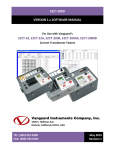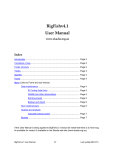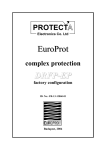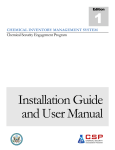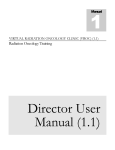Download Emergency Preparedness Communications Plan (EPCP)
Transcript
Salt Lake County Emergency Operations Center • Emergency Preparedness Communications Plan Page | 1 Emergency Preparedness Communications Plan (EPCP) The EPCP is contained in the Salt Lake County Emergency Operations Plan (EOP, Section 8). It is to be used as part of the EOP or as a stand-alone document to instruct and assist in Emergency Operation Center (EOC) activation and drills. Administered by the Unified Fire Authority Status: Version: Release Date: Living Document Public Version 7/1/2014 Salt Lake County Emergency Operations Center • Emergency Preparedness Communications Plan Page | 2 Table of Contents TABLE OF CONTENTS .......................................................................................................................................... 2 DOCUMENT CONTROL ......................................................................................................................................... 4 EXECUTIVE OVERVIEW ........................................................................................................................................ 5 OVERALL COMMUNICATION NETWORK INFRASTRUCTURE .......................................................................... 6 TERRESTRIAL (LAND-BASED) NETWORK INFRASTRUCTURE ....................................................................... 6 MICROWAVE DATA NETWORK INFRASTRUCTURE ......................................................................................... 6 SATELLITE BACKUP COMMUNICATION INFRASTRUCTURE ........................................................................... 7 HOW TO MAKE AN OUTBOUND CALL OVER SATELLITE FROM THE EOC .................................................... 9 HOW TO ROUTE INCOMING CALLS TO THE SATELLITE & VIRTUAL PBX ...................................................... 9 ACTIVATION OR DEACTIVATION OF CALL FORWARDING - CENTURY LINK BUSINESS CONTINUATION ROUTING (BCR) ..................................................................................................................................................... 9 HANDLING INCOMING CALLS – LOGGING IN TO THE HOSTED OR VIRTUAL PBX ..................................... 10 EMERGENCY INFORMATION HOTLINES .......................................................................................................... 10 EMERGENCY OR MASS NOTIFICATION SERVICE .......................................................................................... 11 EMERGENCY CONFERENCING ......................................................................................................................... 11 MAINTAINED DIRECTORIES............................................................................................................................... 12 WHAT DO I DO WHEN COMMUNICATIONS ARE DISRUPTED? ...................................................................... 13 SYSTEM TESTING AND TRAINING .................................................................................................................... 14 ANNUAL EVALUATION OF THE EMERGENCY COMMUNICATION PLAN ..................................................... 14 APPENDIX A – TELEIRA VOICESHIELD USER MANUAL (VIRTUAL PBX) ...................................................... 15 APPENDIX B –TELEIRA VOICECAST – USER MANUAL - EMERGENCY NOTIFICATION ............................. 15 APPENDIX C - LINE FORWARDING SCHEDULE............................................................................................... 15 Salt Lake County Emergency Operations Center • Emergency Preparedness Communications Plan Page | 3 APPENDIX D - TOLL FREE & VOIP INVENTORY (ACCESS NUMBERS) ......................................................... 15 APPENDIX E – DIRECTORIES ............................................................................................................................ 15 APPENDIX F – EOC FIBER ROUTES ................................................................................................................. 15 APPENDIX G – MICROWAVE SCHEMATIC ....................................................................................................... 15 APPENDIX H – SATELLITE BROADBAND MEMORANDUM OF UNDERSTANDING .................................... 15 APPENDIX J - CELLULAR SERVICE OVER SATELLITE - MEMORANDUM OF UNDERSTANDING ........... 15 APPENDIX K - TESTING/TRAINING RECORDS ............................................................................................... 15 Salt Lake County Emergency Operations Center • Emergency Preparedness Communications Plan Page | 4 Document Control Author Prepared under the direction of Clint Mecham, (801) 743-7103, [email protected] Specialist Document Approval This document has been approved for use by the following: Erik Sandstrom Clint Mecham Wade Watkins Amendment History Issue Date Amendments Completed By V1.0 5/01/2014 Pre-release draft Jim Gledhill V2.0 6/1/2014 First Final Draft JG V5.0 71/2014 First Release Clint Mecham Certified Backup Communication Administrators Name Title Date Certified By Clint Mecham Emergency Manager 5/01/2012 Josh Lupresto Warren James Communication Specialist 5/01/2012 Josh Lupresto Justin Watters Communication Specialist 6/1/2014 Mark probert Wade Watkins Deputy Emergency Manager 5/1/2014 Distribution List The Emergency Preparedness Communications Plan (EPCP) is maintained in the cloud on a Dropbox account. The plan is shared with the following individuals who will always have immediate access on their computers to the latest version of the document. The date and version of the plan is found on the front page. Title Communication Specialist Communication Specialist Emergency Manager Telecommunications Preparedness Consultant Teleira Account Manager Name Warren James Justin Watters Clint Mecham Jim Gledhill Mark Probert Salt Lake County Emergency Operations Center • Emergency Preparedness Communications Plan Page | 5 Executive Overview Numerous after action reports from major incidents throughout the history of emergency management in the U.S. have cited communication difficulties as a major failing. Effective communication is a critical challenge to overcome in mitigating, responding and recovering from a disaster. The emergency preparation communication plan (EPCP) for Salt Lake County has been designed to provide communication operability in the event that the worst possible communication scenario occurs: all the traditional telephony infrastructure for a radius of 100 miles is destroyed or otherwise fails. For this, Salt Lake County Emergency Management utilizes a hosted communication system: a cloud-based virtual PBX (Private Branch exchange), which the EOC is ALWAYS connected to through a secure high orbit geostationary satellite. The Emergency Operation Center (EOC) is the location from which centralized management of all county jurisdiction response is performed. The virtual PBX can distribute calls throughout the EOC in the event that the existing PBX connections fail. With the advanced virtual PBX designed specifically for emergency use, the EOC management team has control over all incoming and outgoing calls. Due to the number of jurisdictions in Salt Lake County that may use the EOC, over 90 satellite telephone lines have been installed and connected to the EOC’s existing PBX or red satellite phones. In the event of existing broadband failure, limited internet connectivity is also restored via the satellite connection. A limited number of cellular phones will also be automatically connected to their existing cellular network (Verizon Wireless only) via satellite. Those mobile phones will be registered on their cellular provider’s existing network, and can make and receive cellular calls even though all cellular networks in the area may have failed. This gives the EOC the flexibility to adapt to almost any scenario. For example, at the time of a major disaster, there might be 120 incoming calls to the EOC, which has the personnel to answer just 40 calls at any one time. With the advanced virtual PBX, the EOC has the ability to immediately configure operations in the cloud to filter the incoming calls with an auto attendant. Critical calls are then answered by EOC staff without callers in distress receiving a busy signal. The communication strategies contained in this plan have been designed to maximize resilience and availability. They cannot however guarantee that 100% of all calls will be answered in all circumstances or that others in the region will have voice or internet connectivity. The National Emergency Communication Plan1 mentions that there is no simple solution or “silver bullet” to solve communication operability problems. Nevertheless, by using the latest advances in technology we can prevent or minimize the communication failures that have plagued emergency management in the past. 1 https://www.dhs.gov/xlibrary/assets/national_emergency_communications_plan.pdf Salt Lake County Emergency Operations Center • Emergency Preparedness Communications Plan Page | 6 Overall Communication Network Infrastructure The communications capability for the EOC is defined in six layers: Layer 1. A redundant terrestrial self-healing fiber ring provided by the local telephone company. Layer 2. Microwave broadband ring connecting other public safety stakeholders Layer 3. Voice over Internet. If voice lines fail, incoming and outgoing calls are routed over the internet and are connected to the virtual PBX. Layer 4. Voice over satellite. If both voice and internet links fail, incoming and outgoing calls are routed over satellite and are connected to the virtual PBX. Layer 5. Voice over satellite phones. If onsite telephone equipment fails, calls are routed over the satellite to independent analog telephones. Layer 6. Voice to the cloud. In the event of an evacuation or partial evacuation, incoming calls are routed to the cloud and sent to alternate sites or cell phones. The EOC has real time control over what messages are heard and where calls are routed. In addition to the six layers of protection mentioned above, in the event that cellular service fails or is congested, cellular service will be restored via satellite at the EOC (requires Verizon mobile service). Terrestrial (Land-based) Network Infrastructure Over the last 15 years the EOC has constructed a robust, redundant terrestrial network infrastructure. This includes a fiber optic SONET ring that connects the EOC campus to the County office complex. The SONET ring has been designed to include two different telephone company central offices. If one central office fails, the other office can still deliver dial tone to the EOC and the County office complex. The control of this terrestrial network is the responsibility of Century Link, the local telephone company. Terrestrial networks, including Internet connections, are nonetheless at risk from natural disasters and damage caused by third parties: for instance, construction work inadvertently leads to physical phone circuits being destroyed. See exhibit 1. For detailed drawings of layer 1 fiber routes see Appendix F Microwave Data Network Infrastructure The EOC in conjunction with other public safety stakeholders has completed a high capacity broadband microwave ring connecting the EOC to Salt Lake City Public Safety, Utah Highway Patrol HQ, Valley Emergency Communications Center (VECC) and Salt Lake Airport Authority. The microwave dishes are equipped with an auto align feature that will aid the equipment to auto correct in the event of an earthquake. See exhibit 1. For a detailed schematic see Appendix G Salt Lake County Emergency Operations Center • Emergency Preparedness Communications Plan Page | 7 Satellite Backup Communication Infrastructure The backup communication infrastructure consists of a 2Mb/s X 2Mb/s data connection to a high orbit geo-stationary satellite. The connection terminates in California where data traffic is sent over the public internet and voice traffic connects to the cloud. The EOC’s satellite connection is monitored by the vendor and alarms are sent out EOC emergency managers by the satellite vendor in the event of a connection interruption. The connection can transport 90 simultaneous voice calls to the EOC PBX. Unused capacity in the connection is available for data. All voice packets are sent with priority over data packets to optimize the real time voice quality of service (QOS). The EOC controls this network and the virtual PBX. See exhibit 1. The connection via satellite to the internet has been split (hard coded) in to two segments, voice and data (50/50). The voice has been compressed so that 90 concurrent telephone calls can be made. The data connection is only a fraction .001% of the EOCs primary connection and is not connected to their existing network. In order to connect to the satellite broadband network a wireless connection to the “EOC Satellite” wireless network will need to be initiated by each approved user. For user instructions and password see Appendix H Satellite Broadband memorandum of Understanding. See Exhibit 2 for a diagram of the satellite connectivity. Salt Lake County Emergency Operations Center • Emergency Preparedness Communications Plan Page | 8 Salt Lake County Emergency Operations Center • Emergency Preparedness Communications Plan Page | 9 How to make an Outbound call over Satellite from the EOC There are three different ways to make an outbound call over satellite from within the EOC. 1) Use the existing PBX at the EOC. Dial 8, 1-area code–XXX–XXXX 2) Go to one of the 24 RED phones that are marked “Satellite Phone” dial 1-area codeXXX-XXXX 3) The last method is to use your cell phone. The cell phone must be near the wireless network extender. This method should be used as a last resort as it is less reliable and uses more bandwidth. How to Route Incoming Calls to the Satellite & Virtual PBX All primary and backup communication paths to the EOC are connected 24X7 to the facility. In the event of any telephone disruption where incoming calls are not connecting to the primary PBX at the EOC, selected individuals at EOC have the security clearance to redirect the incoming calls to the Virtual PBX platform. Here, the calls will be routed seamlessly over satellite to the PBX at the EOC or any other assigned designation. EOC personnel have real time control of the virtual PBX through a secure satellite internet connection. In the event that the EOC facility is damaged or evacuated, system administrators can control where calls are sent, how calls are handled and what messages callers hear. To view the user manual for the Virtual PBX see Appendix A. The redirection of calls to the backup facility utilizes a call forwarding feature provided by Century Link, the local telephone company. In many cases the redirection of incoming calls can be done by EOC personnel without involving the phone company by dialing a toll free number from any touchtone phone and entering a security code. To restore calls to the facility on the primary route, the reverse procedure is followed. Activation and deactivation procedures are detailed in the next section. Activation or Deactivation of Call Forwarding - Century Link Business Continuation Routing (BCR) Detailed instructions of how to activate and deactivate Century Link’s BCR and redirect the EOC’s incoming calls to the backup telephone system and satellite dish at the EOC have been printed on wallet size cards and distributed to the following individuals: Clint Mecham Warren James Jeff Graviett In the event that primary telephone service at the EOC is lost, it is the responsibility of a member of the EOC staff to activate BCR. The procedure for redirection of incoming calls to the satellite is: Dial 888-801-8052 Enter XXXXXXXXXX# Enter XXXX#, Press 1 Enter XXXXXXXXXXXXX# (13 digit password on the individual’s activation card) Salt Lake County Emergency Operations Center • Emergency Preparedness Communications Plan Page | 10 Enter 1 (deactivation press 2) Enter 1 Deactivation follows the same procedure, except press 2 after the password. To view the list of protected local telephone numbers see Appendix C. Line Forwarding Schedule Handling Incoming Calls – Logging in to the Hosted or Virtual PBX The satellite connection on the roof of the EOC connects directly to the PBX of the EOC. In the event that primary telephone service fails, incoming calls will need to be triggered so they will route to the EOC over satellite. If the satellite connection reaches full capacity then calls will overflow to the cloud based virtual PBX telephone system. In this case the caller will be greeted with user friendly menus and options, while connecting the caller to any alternate communication device such as a cell phone, voice over IP phone, home phone or other assigned communication device. The redirection of incoming calls will remain seamless to the caller, who will perceive the facility to be fully operational. The menu options and the destination to which calls are directed can be changed in minutes to adjust for almost any scenario. The EOC’s staff and business continuity personnel have been trained on updating the virtual PBX. Here is the login information for the hosted PBX. www.teleira.com Username: xxxxxxxxx, Password: xxxxxxxxx. A user manual can be found in Appendix A. The hosted PBX has a number of features that when deployed will streamline communications optimizing the EOC resources. The following is a list of the features contained in the hosted PBX. or backup phone system: Uniform Call Distribution among pre-selected groups Call forwarding to any number in the U.S. Call screening Find/Follow which attempts to find the recipient at multiple locations Whisper messages which inform the call recipient of the nature of the call Dial by name directories Dial by extension directories Play messages Collect voicemail – store and distribute electronically Collect faxes – store and distribute electronically Location locator finds the closest facility to the caller Conference calls Emergency (proactive) conference calls Emergency Information Hotlines The EOC has several toll free information lines that can be used to disseminate information of any kind. Different hotlines are set up for employees, command, media, and the public. Information hotlines can also be menu-driven to customize the response that is heard depending on the criteria entered by the caller. Information Hotlines can be updated by authorized personnel from any touchtone phone. Currently these numbers have not been released, we Salt Lake County Emergency Operations Center • Emergency Preparedness Communications Plan Page | 11 expect the employee hotline to be released in 2014. Below is a list of the toll free hotline numbers: (for instructions on recording information for a hot line see appendix A) Toll Free Number (888) 252-8706 (888) 252-8420 (877) 218-8660 (888) 252-7581 Description 1 Employee Hotline 2 Media Hotline 3 Public Hotline 4 Command Hotline Emergency or Mass Notification Service The EOC utilizes a cloud based emergency notification service, which can broadcast up to 60,000 recorded messages, email messages, or SMS text messages per hour, to home phones, cell phones, business phones, employees, suppliers and first responders. The EOC has identified several primary uses for emergency notification services, which include: Staffing administration. Schedule staff and manage emergency staffing, training, and family support. Logistics. Announce the location of available facilities during incidents. Order and issue needed equipment and supplies. Safety and security. Monitor, verify, and distribute information related to any threat; keep police and safety personnel fully informed. Business continuity. Prevent communication disruptions and disseminate critical information about vital supplies, facility relocation, or staffing issues. Emergency operations. Mobilize emergency staff, rapidly and continuously coordinate with other agencies or municipalities, and report ongoing status to key administrators. Real-time audit trail. Frees key personnel to perform other critical tasks during emergencies, while reducing the human error factor found in traditional calling trees while providing real time audit trail reporting, receipt of messages non-completions and member responses. Emergency Conferencing The collaboration and the sharing of information between emergency management, first responders, volunteers, elected officials and other groups are essential, in any type of incident. The Emergency Conferencing function is used to call a group of people at the same time on their cell phones, business phones or home phones and ask them to join a conference call that is in session. To join the conference, they are instructed to press “1” on the telephone. They are then instantly added to the conference bridge. Emergency conferencing can be held as needed, scheduled ahead of time and/or at regular intervals. Salt Lake County Emergency Operations Center • Emergency Preparedness Communications Plan Page | 12 Maintained Directories There are several different directories maintained by Emergency Management staff. The following is a listing of directories: EOC/UFA employees Elected officials Emergency management in each jurisdiction State and local emergency staff Emergency Management Staff in adjoining cities and counties Volunteers The directory also contains their extension (optional), their cellphone number for text (SMS) messages, the group(s) they are associated with, and their email address. See appendix E for the directory breakdown and last date updated. Salt Lake County Emergency Operations Center • Emergency Preparedness Communications Plan Page | 13 What Do I Do When Communications are disrupted? Telecommunication Disruption Scenarios The following is a list of possible scenarios and solutions where telephone calls cannot reach the EOC or cannot be made using existing systems and processes. To review the actual steps necessary to make a satellite call or reroute telephone calls, see previous chapters; “How to make an Outbound call over Satellite from the EOC” and “How to Route Incoming Calls to the Satellite & Virtual PBX”. Scenario 1 Telephone lines or the telephone system is down. Staff is on-site and available, but incoming calls cannot be answered, and when you pick up the black EOC telephone you cannot dial an outside line. This could be a short-term or long-term situation. Solution: Redirect incoming calls to the backup telephone switch and direct outbound calls over satellite. (to make outbound calls over satellite dial 8 instead of 9 from the PBX) Scenario 2 An incident has occurred in the County and telephone lines along with cellular lines are working but congested allowing very few calls in or out of the EOC facility. Solution: Make all outbound calls over satellite. Publish toll free numbers for the EOC that come in over satellite. Redirecting incoming calls over satellite may or may not help, it will depend on the place of congestion. Scenario 3 Cellular service does not work in the EOC. Solution: To activate Verion Wireless over satellite locate the power strip to the cellular network extender and turn it on. It takes up to 10 minutes to register itself on the Verizon network. The power strip is in the operations room and is clearly marked. (see exhibit 2 Satellite Connectivity Diagram) Scenario 4 An incident has occurred in the County and the EOC has been activated. Cellular service has been disrupted. Someone is expecting an important call on their cell phone. Solution: Have that person call the party that needs to contact him/her and provide them with an EOC satellite toll free number (see appendix D). If that is not possible then place that person with cell phone near the cellular network extender. (at this time only Verizon Wireless is extended to the EOC over satellite). Scenario 5 An incident has occurred and a group of employees need to be notified of critical information. Solution: send all employees in the group a voice message and a text message providing them the required information using the Emergency Notification system. See appendix B – manual for emergency notification system. Place important voice messages on any of the four hotlines, employee, public, media or command. Salt Lake County Emergency Operations Center • Emergency Preparedness Communications Plan Page | 14 Scenario 6 An incident has occurred, and all management needs to immediately communicate and discuss ideas and possible solutions. Solution: convene an emergency conference bridge by calling all of the management team on their primary or alternate numbers and placing them on an instant conference bridge. To do this, either go online and log in to a secure facility, or call a toll free number and enter a PIN to initiate the call to all management. System Testing and Training The EOC has elected to have their vendor responsible for monitoring testing, performing training and validating directory accuracy. This will be done through a quarterly telephone interview with each administrator. In the event that new people need to be trained on how the emergency communication plan has been designed and/or how the virtual PBX handles calls, the EOC vendor is under contract to assist in any additional training necessary. A record of testing/training can be found in Appendix K. Annual Evaluation of the Emergency Communication Plan Annually, the EOC will go through a thorough evaluation of the effectiveness of the existing Emergency Preparation Communication Plan. Every year during the annual evaluation, the call forwarding features will be thoroughly tested by the EOC’s telecom department. Updates and changes in the written EPCP will be maintained by the EOC vendor and shared via dropbox. Salt Lake County Emergency Operations Center • Emergency Preparedness Communications Plan Page | 15 Appendix A – Teleira VoiceShield User Manual (Virtual PBX) Appendix B –Teleira Voicecast – User Manual - Emergency Notification Appendix C - Line Forwarding Schedule Appendix D - Toll Free & Voip Inventory (Access Numbers) Appendix E – Directories Appendix F – EOC Fiber Routes Appendix G – Microwave schematic Appendix H – Satellite Broadband Memorandum of Understanding Appendix J Cellular Service over Satellite - Memorandum of Understanding Appendix K - Testing/Training Records























